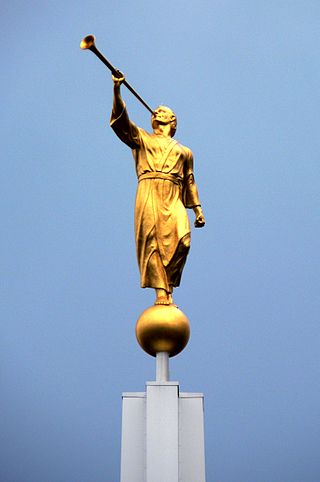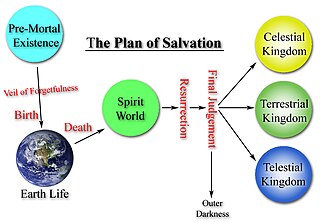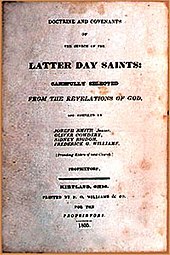
The Standard Works of the Church of Jesus Christ of Latter-day Saints are the four books that currently constitute its open scriptural canon. The four books of the standard works are:

The angel Moroni is an angel whom Joseph Smith, founder of the Latter Day Saint movement, reported as having visited him on numerous occasions, beginning on September 21, 1823. According to Smith, the angel Moroni was the guardian of the golden plates buried near his home in western New York, which Latter Day Saints believe were the source of the Book of Mormon. An important figure in the theology of the Latter Day Saint movement, Moroni is featured prominently in its architecture and art. Besides Smith, the Three Witnesses and several other witnesses also reported that they saw Moroni in visions in 1829.
In Mormonism, the Melchizedek priesthood, also referred to as the high priesthood of the holy order of God or the Holy Priesthood, after the Order of the Son of God, is the greater of the two orders of priesthood, the other being the Aaronic priesthood.
In Mormonism, the restoration refers to a return of the authentic priesthood power, spiritual gifts, ordinances, living prophets and revelation of the primitive Church of Christ after a long period of apostasy. While in some contexts the term may also refer to the early history of Mormonism, in other contexts the term is used in a way to include the time that has elapsed from the church's earliest beginnings until the present day. Especially in the Church of Jesus Christ of Latter-day Saints "the restoration" is often used also as a term to encompass the corpus of religious messages from its general leaders down to the present.

The Book of Commandments is the earliest published book to contain the revelations of Joseph Smith Jr. Text published in the Book of Commandments is now considered scripture by the Church of Jesus Christ of Latter-day Saints as part of the larger Doctrine and Covenants.
In the early Latter Day Saint movement, the School of the Prophets was a select group of early leaders who began meeting on January 23, 1833 in Kirtland, Ohio under the direction of Joseph Smith for both theological and secular learning.
David Wyman Patten was an early leader in the Latter Day Saint movement and an original member of the Quorum of the Twelve Apostles. He was killed at the Battle of Crooked River and is regarded as a martyr by members of the Church of Jesus Christ of Latter-day Saints. He is referred to twice in the Church of Jesus Christ's Doctrine and Covenants—once in section 114 and posthumously in section 124.

Orson Hyde was a leader in the early Latter Day Saint movement and a member of the first Quorum of the Twelve Apostles. He was the President of the Quorum of the Twelve Apostles of the Church of Jesus Christ of Latter-day Saints from 1847 to 1875 and was a missionary of the LDS Church in the United States, Europe, and the Ottoman Empire.

William Earl McLellin was an early leader in the Latter Day Saint movement. One of the original members of the Quorum of the Twelve Apostles, McLellin later broke with church founder Joseph Smith.

According to the Book of Mormon, the Anti-Nephi-Lehies were an ethnic group of Lamanites formed around 90 BC in the Americas, after a significant religious conversion. They made a covenant that they would not participate in war, and buried their weapons. Eventually they changed their name to the people of Ammon, or Ammonites. During a later period of warfare, the young men of the group who had not made the pacifist covenant became a military unit known as the two thousand stripling warriors, and were protected by divine intervention.

The Pearl of Great Price is part of the canonical Standard Works of the Church of Jesus Christ of Latter-day Saints and some other Latter Day Saint denominations.

In the theology and cosmology of Mormonism, in heaven there are three degrees of glory which are the ultimate, eternal dwelling places for nearly all who have lived on earth after they are resurrected from the spirit world.
Joseph Knight Sr. was a close associate of Joseph Smith, founder of the Latter Day Saint movement. Knight provided significant material support to Smith's translation and publication of the Book of Mormon.

In the Latter Day Saint movement, the term Urim and Thummim refers to a descriptive category of instruments used for receiving revelation or translating languages. According to Latter Day Saint theology, the two stones found in the breastplate of Aaron in the Old Testament, the white stone referenced in the Book of Revelation in the New Testament, the two stones bound by silver bows into a set of spectacles (interpreters) that movement founder Joseph Smith said he found buried in the hill Cumorah with the golden plates, and the seer stone found while digging a well used to translate the Book of Mormon are all examples of Urim and Thummim. Latter Day Saint scripture states that the place where God resides is a Urim and Thummim, and the earth itself will one day become sanctified and a Urim and Thummim, and that all adherents who are saved in the highest heaven will receive their own Urim and Thummim.
In the Latter Day Saint movement, the Quorum of the Twelve is one of the governing bodies of the church hierarchy organized by the movement's founder Joseph Smith and patterned after the Apostles of Jesus. Members are called Apostles, with a special calling to be evangelistic ambassadors to the world.
Steven Craig Harper is a professor of church history and doctrine at Brigham Young University. He was a historian for the Church History Department of the Church of Jesus Christ of Latter-day Saints. From 2019, he is the Editor-in-Chief of BYU Studies Quarterly.

Eyewitness accounts associated with the Joseph Smith Papyri have been analyzed extensively to understanding the content, purpose and meaning of the Book of Abraham, a canonized text of the Latter Day Saint movement. In 1835, Joseph Smith, founder of the Latter Day Saint movement, came into possession of four mummies, two papyrus rolls, and various papyrus fragments, which Smith said contained the writings of the ancient biblical patriarchs Abraham and Joseph.










